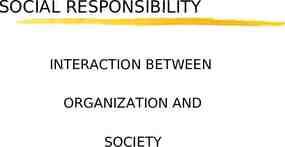THE BIG FIVE Presented by: Meghan Purdy
24 Slides133.20 KB
THE BIG FIVE Presented by: Meghan Purdy
OUTLINE Introduction History of the Big Five Dimensions of the Big Five Test Examples Test Psychometric Properties Big Five Relationship with Job Satisfaction Job Performance Leadership Criticisms of the Big Five
INTRODUCTION The Big Five are five broad factors (or dimensions) of personality traits. Personality a comprehensive profile of someone’s personality traits Conceptual framework used to classify lower-level personality constructs The most commonly accepted clarification is the Five-Factor Model (FFM) developed by Costa and McCrae (1992).
HISTORY TIMELINE Allport & Odbert 4000 traits 1936 Sir Francis Galton Lexical Hypothesis Eysenck P-E-N 1940 Cattell 16 traits 1947 Goldberg 5 traits 1958-1961 Tupes & Christal 5 traits 1990 1992 Costa & McCrae 5 traits
HISTORY Sir Francis Galton – first major inquiry into the Lexical Hypothesis The most salient and socially relevant personality differences in people’s lives will eventually become encoded into language Gordon Allport and H.S. Odbert (1936) The more important the attribute, the more synonyms it will acquire. Tested the hypothesis: by sampling language, it is possible to derive a comprehensive taxonomy of personality traits Raymond Cattell (1940) Identified 35 major clusters of personality traits to create the “personality sphere” Led to the development of the 16PF Personality Questionnaire
HISTORY Hans Eysenck (1947) Three personality dimensions (P-E-N) Psychoticism-Socialization 2. Introversion-Extroversion 3. Neuroticism-Emotional 1. Tupes & Christal (1958, 1961) Factor analysis of Cattell’s traits used to analyze how personality traits are correlated Suggested that only 5 traits were predominant Goldberg (1990s) Coined the term the “Big Five” Replicated Cattell’s methods and also found five factors: Surgency, Agreeableness, Conscientiousness, Emotional Stability and Culture
HISTORY Costa & McCrae (1992) Used the questionnaire approach Ask participants to describe self/target sentences vs single adjectives Factor Analysis First found Extroversion & Neuroticism, followed by Openness to Experience. Agreeableness & Conscientiousness were adopted as there was “some evidence” and it fit with the 5 factors of Goldberg
DIMENSIONS: THE BIG FIVE Extraversion High Positive emotions, surgency, and the tendency to seek out simulation and the company of others Gregariousness Activity Level Assertiveness Excitement Seeking Positive Emotions Warmth Low Reserved Loner Quiet
DIMENSIONS: THE BIG FIVE Agreeableness High Tendency to be compassionate and cooperative rather than suspicious and antagonistic toward others Straightforwardness Trust Altruism Modesty Tender-mindedness Compliance Low Aggressive Ruthless Suspicious
DIMENSIONS: THE BIG FIVE Conscientiousness High Tendency to show self-discipline, act dutifully, and aim for achievement Self-disciple Dutifulness Competence Order Deliberation Achievement Striving Low Lazy Aimless Quitting
DIMENSIONS: THE BIG FIVE Neuroticism High Tendency to experience negative emotions, such as anger, anxiety or depression Anxiety Self-consciousness Depression Vulnerability Impulsiveness Hostile Low Calm Even-tempered Unemotional Hardy
DIMENSIONS: THE BIG FIVE Openness to Experience High General appreciation for art, emotion, adventure, unusual ideas, imagination, curiosity and variety of experience Fantasy Aesthetics Feelings Ideas Actions Values Low Down-to-earth Conventional Uncreative Prefer routine
TEST EXAMPLES NEO Five Factor Inventory (NEO-FFI) Formats 1. 2. 3. Full sentences, 240 items (Costa & McCrea , 1988) Self Report – 240 items, roughly 35 minutes to complete Observer Report – 240 items Short Form – 60 Items, self report Measurement Each domain (factor) is measured in terms of 6 facets Item example: E5 Excitement Seeking “Have sometimes done things just for “kicks” or thrills
PSYCHOMETRIC PROPERTIES In 1991, John and Srivastava (1991) looked at the validity and reliability of three commonly used instruments: 1. NEO-Five Factor Inventory 2. Trait Descriptive Adjectives 3. Shorter version of the original NEO instrument Shows the most validity for the Big Five dimensions 100 items Uses single adjectives to measure Big Five Inventory Measures core features of the Big Five Uses short phrases rather than one work traits Frequently used in research settings Items provide more context than one word items
RELIABILITY Conscientious Neuroticism Openness Mean -ness Extraversion Agreeable-ness TDA 0.92 0.90 0.90 0.85 0.88 0.89 BFI 0.88 0.79 0.82 0.84 0.81 0.83 NEO 0.78 0.78 0.83 0.85 0.81 0.79 Mean 0.87 0.83 0.85 0.85 0.81 0.84
VALIDITY Uncorrected Pairwise Convergent Validities E A C N O Mean BFI-TDA 0.90 0.78 0.81 0.76 0.75 0.81 BFI-NEO 0.69 0.76 0.79 0.76 0.64 0.73 TDA-NEO 0.67 0.68 0.77 0.70 0.56 0.68 Mean 0.78 0.74 0.79 0.74 0.66 0.75 O Mean E Corrected Pairwise Convergent Validities A C N BFI-TDA 0.99 0.93 0.94 0.90 0.89 0.95 BFI-NEO 0.83 0.97 0.96 0.90 0.85 0.92 TDA-NEO 0.79 0.81 0.89 0.82 0.71 0.81 Mean 0.93 0.92 0.94 0.88 0.83 0.91
BIG FIVE AND JOB SATISFACTION 1. Neuroticism Experience more negative life events than other individuals 2. If these experiences occur at work it will lead to decreased job satisfaction Extraversion 3. Put themselves in situations that foster negative affect Predisposed to experience positive emotions to generalize to job satisfaction (Connolly & Viswesvaran, 2000) Likely to find interpersonal interactions at work to be more rewarding Openness to Experience Related to scientific and artistic creativity, divergent thinking, and low liberalism Predisposed individuals to feel both the good and bad more deeply Not closely related to job satisfaction because job satisfaction is subjective
BIG FIVE AND JOB SATISFACTION 3. Agreeableness 5. Involves getting along with others in pleasant, satisfying relationships Positively related to life satisfaction Assuming these same motivations operate on the job, the same process should operate with respect to job satisfaction Conscientiousness Positive relationship suggested between conscientiousness and job satisfaction Represents a general work-involvement tendency leading to a greater likelihood of obtaining satisfying work rewards Formal pay, promotions Informal recognition, respect, feelings of personal accomplishment
BIG FIVE AND JOB SATISFACTION Correlations with job satisfaction The relationship between conscientiousness and agreeableness with job satisfaction did not fully generalize across studies Neuroticism -.29 Conscientiousness .26 Extraversion .25 Openness to experience .02 80% credibility value included 0 Why do you think the relationship with agreeableness was not as strong as the other traits?
BIG FIVE AND JOB SATISFACTION Meta-Analysis of the Relationship of Personality to Job Satisfaction Trait k Average N r p SD 80% CV Lower Upper 90& CI Lower Upper Neuroticism 92 24.52 -.24 -.29 .16 -.50 -.08 -.33 -.26 Extraversion 75 20.18 .19 .25 .15 .06 .45 .22 .29 Openness to Experience 50 15.19 .01 .02 .21 -.26 .29 -.05 .08 Agreeableness 38 11.85 .13 .17 .16 -.03 .37 .12 .22 Conscientiousness 79 21.72 .20 .26 .22 -.02 .55 .21 .31 k number of correlations, N combined sample size, p estimated true score correlations, SD standard deviation of true score correlation, CV credibility interval, CI confidence interval
BIG FIVE AND JOB PERFORMANCE Barrick & Mount (1991): meta-analysis to compare the Big Five dimensions to three job performance criteria and five occupational groups Conscientiousness: consistent relation with all job performance criteria (i.e., turnover or tenure) and occupational group (i.e., police) Validity 0.2 Extroversion: predicted success in management and sales Openness and Extroversion: predicted training proficiency Agreeableness and Neuroticism: some evidence to suggest that they contribute to performance in group settings
BIG FIVE AND LEADERSHIP Judge & Bono (2000): Transformational Leadership – leader’s ability to inspire followers with a vision beyond their own self-interest Four dimensions: Results: Idealized influence, inspirational motivation, intellectual stimulation, individual consideration Big Five and TL .40 Agreeableness and TL .32 Judge et al. (2002): Relationship between leadership emergence and leadership success to the Big Five traits Results: Conscientiousness and Extroversion predicted leader emergence
CRITICISMS OF THE BIG FIVE 1. Frequent objection to the Big Five dimensions is that five dimensions is too few to capture all variation in personality 2. Discrepancies about which five should be considered the Big Five 3. 4. Dimensions are too broad Many different names for the terms as they are, but there is a large amount of agreement on the “meaning” of the five. Openness to experience does not usually generalize across cultures and countries Broad categories low fidelity Not very useful for predicting specific behaviors
QUESTIONS?





























